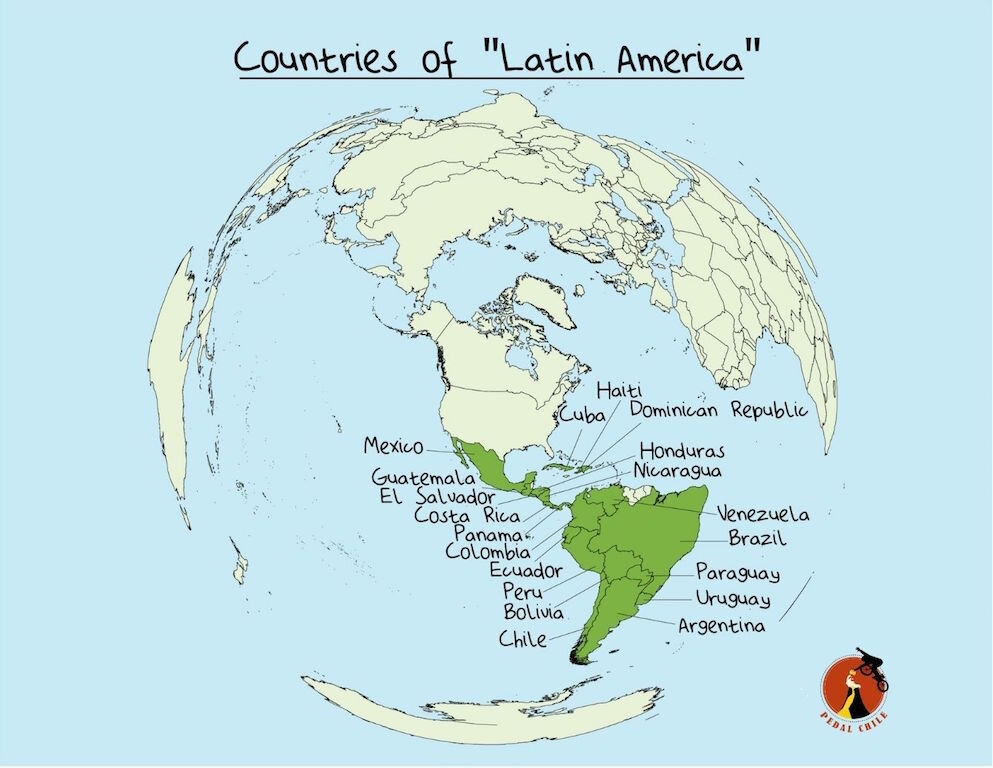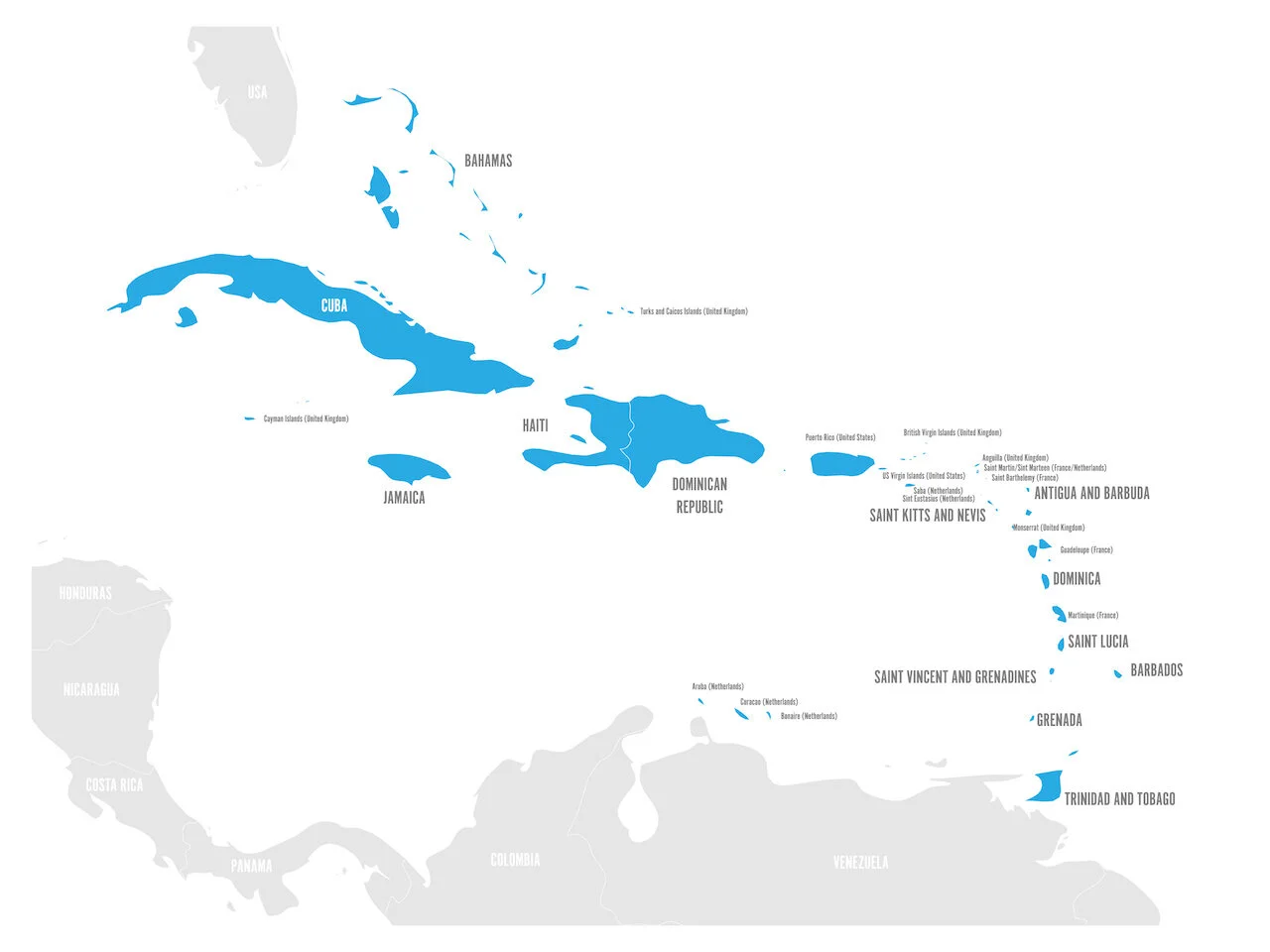The term “Latin America” means different things to different people. “Americans” understanding of this term is based mostly on stereotypes rather than facts. Many “Americans” imagine some poor “3rd World” improvised nation where the locals take siestas while wearing some oversized brimmed hat.
Even many analysts and “experts” erroneously define Latin America as encompassing all the countries south of the United States, including the English, French, and Dutch-speaking countries, plus the U.S. commonwealth of Puerto Rico.
Map of the traditional 20 countries of Latin America
Is Puerto Rico part of Latin America?
Puerto Rico is excluded from Latin America as it has never been independent (commonwealth of USA) and doesn’t share the key characteristics, such as post-independence timing, geopolitics, or liberated bureaucratic organization.
Traditional Latin America
Historically, Latin America was limited to 20 countries (see the above map):
The 10 Spanish and Portuguese speaking countries of South America
Argentina, Bolivia, Brazil, Chile, Colombia, Ecuador, Paraguay, Peru, Uruguay, Venezuela
The 6 Spanish speaking countries of Central America (Belize speaks English)
Costa Rica, El Salvador, Guatemala, Honduras, Panama, Nicaragua
Mexico
Cuba, Haiti, and the Dominican Republic in the Caribbean region
Shared History: Latin America
Geographers and geopolitical historians define Latin America as a group of nations that share 5 core traits:
Geographical
Timing of post-independence
Religion
Linguistic
Cultural
downtown Old San Juan - Puerto Rico
Geographical: Puerto Rico & Latin America
While the vast majority of Central and South America is considered to be part of Latin America - minus the three “Guianas” and Belize. The Caribbean region has traditionally not been associated with Latin America - minus Cuba and the island of Hispaniola (both the Dominican Republic and Haiti share this island).
Map of the Caribbean
The Caribbean has over 700 islands, 26 of which are independent nations - 30 are territories, including sovereign states, overseas departments, and dependencies - with Puerto Rico being one of these 30.
This region, which includes famous tropical islands, such as Aruba, the Bahamas, Barbados, the British and U.S. Virgin Islands, Cayman Islands, Grenada, Guadeloupe, and Montserrat has never been associated with Latin America. Geographically speaking, Puerto Rico is near the Dominican Republic, however, the Caribbean as a whole is not typically associated with Latin America.
Latin America & timing of post-independence
The standard 20 countries of Latin America all gained their independence within decades of each other:
17 of these 20 countries gained their independence within 15 years of each other (Panama is more complex, but fits this timeline).
Haiti was the first to gain independence, only 6 years before the 15 year run of independence.
Puerto Rico, as of 2021, is still a U.S. territory and is NOT an independent nation.
Furthermore, Puerto Ricans, since 1917, have United State citizenship and are free to work and live on the mainland or travel to/from without restriction.
Capital building in San Juan - Puerto Rico
Puerto Rico & Oldest Colony
The title of the oldest colony in the world belongs to Puerto Rico. Christoper Columbus became the first European to land in PR in 1493, remaining under Spanish rule until becoming an unincorporated territory of the United States in 1898.
Historically, Puerto Rico was never considered part of Latin America because it was and remains to this day as part of the United States and is not an independent nation. Puerto Ricans by birth is granted U.S. citizenship and can freely travel and work in any of the 50 states.
The 20 original countries that makeup Latin America are all independent nations, therefore excluding Puerto Rico from the shared experiences of self-government.
Linguistic: Puerto Rico & Latin America
Since Puerto Rico was colonized by Spain in 1493, the Arawakan language of the native Taínos was replaced by Spanish. Even though Puerto Rico wasn’t to become a U.S. territory until 1898, Puerto Rico was trading and conducting business with the U.S. mainland since the 17th century.
In 1902, the Official Languages Act was instituted, which declared that in all governmental departments, courts, and public offices, English was to be regarded as co-official language along with Spanish.
Puerto Rico has two official languages:
English
Spanish
While Spanish is the majority language on the island, English is spoken as a second language by over 50% of the island's residents and is the dominant language in the professional workplace.
Valentina is a guide for Pedal Chile and is our resident badass. Valentina was born and raised in La Patagonia, which probably explains her affinity for adventuring. When Valentina isn’t crushing some poor dude’s soul, you can find her shredding down Rucapillán. Favorite season: Austral Summer
Sources & References
Pousada, Alicia & Alicia,. (1999). The singularly strange story of the English language in Puerto Rico. Milenio. vol. 3. pp.33-61.
Suárez, Sandra L. “Does English Rule? Language Instruction and Economic Strategies in Singapore, Ireland, and Puerto Rico.” Comparative Politics, vol. 37, no. 4, 1 July 2005, p. 459, 10.2307/20072904.















